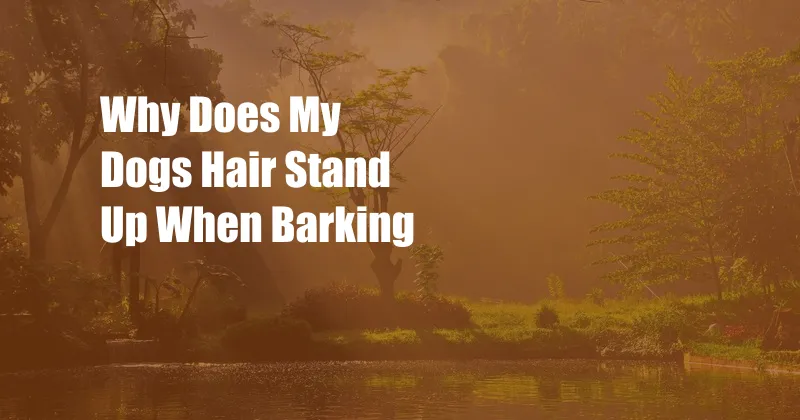
Why Does My Dog’s Hair Stand Up When Barking?
It’s a curious sight to behold – your furry friend standing tall, barking away at a passerby with its hair bristling up. This strange phenomenon is called piloerection, and it has an evolutionary purpose that’s both fascinating and protective.
Piloerection: The Evolutionary Hair-Raising
Piloerection is an involuntary response triggered by the sympathetic nervous system, which activates tiny muscles at the base of each hair follicle. This action makes the hairs stand upright, creating a “poofy” appearance to the coat. While this response is most commonly associated with barking, it can also be triggered by fear, anxiety, excitement, or even cold temperatures.
The Origins of Piloerection
During the dog’s evolutionary journey, the ability to raise its hair served a crucial purpose. When threatened by predators, dogs would instinctively bristle their coats to make themselves appear larger and more intimidating. The raised hairs would also trap air, providing an extra layer of insulation against a potential attack.
The Canine Communication Signal
Beyond its protective function, piloerection plays a significant role in canine communication. When a dog barks with its hair raised, it’s sending out clear signals to its pack or potential threats. The upright hairs communicate a range of emotions, including:
-
Aggression: When combined with a lowered body and bared teeth, piloerection serves as a warning to back off.
-
Fear: If accompanied by cowering, the raised hair indicates that the dog is feeling threatened and needs space.
-
Excitement: When combined with a wagging tail, piloerection conveys a sense of playful anticipation or excitement.
Modern-Day Piloerection
While the protective and communicative aspects of piloerection have diminished in domesticated dogs, it remains an important part of their genetic makeup. Here are some interesting insights:
-
Age and Breed: Piloerection is more pronounced in younger dogs and certain breeds, such as Huskies, Samoyeds, and Spitz.
-
Temperature: Extreme cold can also trigger piloerection as a way to conserve body heat and stay warm.
-
Medical Conditions: Occasionally, excessive piloerection can be a symptom of an underlying health issue, such as infections or neurological disorders.
Tips and Expert Advice
Understanding the reasons behind your dog’s hair-raising habit can help you better interpret their behavior. Here are some tips and expert advice:
-
Respect their Space: If your dog’s hair is standing up during certain situations, such as when you approach them after a bath, give them some space to calm down and feel more secure.
-
Consider their Environment: Try to identify potential triggers in your dog’s surroundings that may be causing anxiety or fear, and try to address them accordingly.
-
Seek Veterinary Advice: If piloerection becomes excessive or persistent, consult a veterinarian to rule out any underlying medical conditions.
Frequently Asked Questions
Q: Why does my dog’s hair stand up around their neck?
A: Raised hair around the neck is often a sign of fear or submission.
Q: Is piloerection harmful?
A: No, piloerection is a normal physiological response and not harmful to dogs.
Conclusion
Understanding why your dog’s hair stands up when barking provides a fascinating glimpse into the evolutionary and communicative world of canines. By respecting their signals and addressing any underlying concerns, you can ensure that your furry companion feels safe, secure, and happy.
Are you interested in learning more about the fascinating world of dog behavior? Explore our blog for a wealth of valuable information and resources to enhance your bond with your canine friend.